Arie Azene, born in Germany in 1934, Lives in Jerusalem. He has had many one man shows since 1960 – in Israel (the Tel Aviv Museum) USA, France, Germany and Switzerland as well as group shows (Paris Biennale). His works are in many museum collections as well as private collections.

Throughout his career Azene has forged personal histories through the exploration of information implicit in the tactile, or that which can be seen. The artist collects, edits and rearranges each pictorial component, carefully controlling the impact of the finished work. Through this process new visual texts are born in his mind, and transferred to the canvas. Through Azene’s inspired composition, an evocative narrative emerges which transcends the sum of its parts.
“The “New Horizons” group - founded in 1948 and active into the early sixties – set itself the target of bringing Israeli art into closer contact with world art.
The group, whose members included Arie Azene, broke down the barriers of provincial localism and prejudice in Isreali art, introducing the Israeli art world to the abstract art of the fifties and early sixties.”
[From “New Horizons”, Gila Ballas, 1979]

“Arie Azene, a member of Kibbutz Tzuba, is one of Zaritsky’s brightest pupils. With his presentation in the context of the ”New Horizons” group, Azene has reduced Zaritsk’s concept to a form of systematic work formula...
The ways and means of working are now his own affair: from our point of view, there remains a careful and precise formulation of the relationship between surfaces: the combination of colourful tissues, the structure of reflection and consolidation of a vivid atmosphere around those three elements.
Azene’s qualities come to light gradually. He is not a “colourist” like Zaritsky; he exhibits a clear inclination towards merging the colour structure around two complementary hues, usual closely to the one another. He prefers various combinations of gray, around which he constructs the combined formal structures, in a two-dimensional way, which likewise is close to Zaritsky’s earliest abstract oils. The form themselves are more blurred, in a progression towards some amorphousness.”


- 1956 Tel-Aviv Museum: Israeli Artists
- 1959 Tel-Aviv Museum: New Horizons
- 1963 Ein Harod Museum: New Horizons
- 1963 Biennale, Paris
- 1965 Tel-Aviv Museum: Young Artists
- 1967 Charlottenburg, Copenhagen
- 1968 Tel-Aviv Museum: Autumn Show
- 1971 Modern Art Museum: Haifa
- 1973 Jerusalem Artist House
- 1975 Tel-Aviv Museum, H. Rubinstein
- 1977 Loeb Gallery, Bern Switzerland
- 1981 Tel-Aviv Museum: New Works
- 1983 Nelly Aman Fine Art, Tel Aviv
- 1992 Elbaz Art Gallery, New York
- 1994 Perry Art Gallery, New York
- 1997 Neve Tzedek Gallery, Tel Aviv
- 2003 Adennauer Center, Jerusalem
- 2005 Art-Time Gallery, Jerusalem
- 2006 "Musrara" Scholl of Photography,
- 2006 UJC L.A
- 2007 Jerusalem Theatre Art Gallery
- 2008 Givatayim Theatre Art Gallery
- 2009 Jerusalem Theatre Art Gallery
- 2010 David Yellin College Art Gallery
- 2011 Matsart Gallery, Tel-Aviv